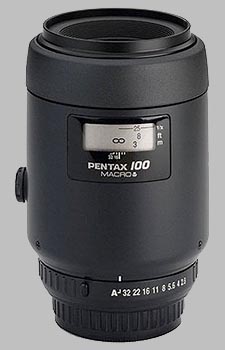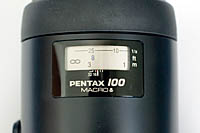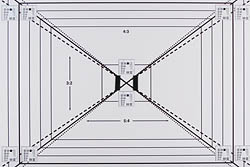| 100mm |
$330 average price |
|---|---|

|
|
Your purchases support this site
Buy the Pentax 100mm f/2.8 Macro SMC P-FA
(From Pentax lens literature) The Pentax SMC P-FA 100mm ƒ/2.8 Macro lens provides 1:1 magnification of your subjects and is ideal for shooting in low-light conditions. It offers a minimum focusing distance of 1 foot and is well-suited for life-size reproductions of coins, flowers, and documents. Like all Pentax lenses, it is treated with the acclaimed SMC multi-layer coating for maximum light transmission, sharp definition, and high contrast while minimizing flare and ghost imaging.
Introduction
The 100mm ƒ/2.8 SMC P-FA has been discontinued and replaced by the P-D FA model, but that doesn't mean it's not still widely available. A full-frame lens design built with several features that make macro shooting a real pleasure, the lens will give an effective field of view of 150mm when mounted on Pentax digital (APS-C) SLR cameras.
The lens comes with a lens cap, but no hood, given that the design makes is so that the lens doesn't need one. While it has been discontinued, its street value is around $450.
Sharpness
The Pentax 100mm ƒ/2.8 Macro is a very sharp lens. Given that we are testing a full-frame lens on a digital APS-C body, the image sensor is focusing on the ''sweet spot'' of the lens, and image quality is excellent. At every aperture except for the smallest, ƒ/32, blur performance ranges between 1 and 2 blur units, with the best results showing at any of ƒ/5.6-ƒ/11 where the image is tack-sharp. At ƒ/32 we are seeing evidence of strong diffraction limiting, producing sharpness results in excess of 3 blur units.
Sharpness results could be different on a film body, where the entire lens is being used, as opposed to the central portion.
Chromatic Aberration
Pentax has obviously spent a lot of effort with its SMC coating, as the results prove true with regard to chromatic aberration. At all apertures we aren't seeing more than 3/100ths of a percent of frame height in chromatic aberration, with an average value of half that. Again, the 100mm has an advantage in this test in that the digital sensor of the K10D test body we used doesn't show light coming in from the more typically problematic outer area of the glass. So, you may (or may not) see more chromatic aberration when paired with a Pentax film body.
Shading (''Vignetting'')
There is little to worry about with regard to shading in the corners when using the 100mm ƒ/2.8 SMC. The ''worst'' result, when used wide open at ƒ/2.8, shows up at a miniscule quarter-stop darker than the center. All other apertures show negligible results for shading.
Distortion
The 100mm ƒ/2.8 has been expertly optimized - the lens shows absolutely no distortion.
Autofocus Operation
The 100mm ƒ/2.8 is mechanically focused by a screw, which results in a fair amount of noise. Considering that the lens can extend a full two inches while focusing, that's a fair amount of travel for the lens to push, but it does manage to rack through the entire focus range it in 2.2 seconds. Focusing is pretty noisy: click here to hear a recording of the 100mm ƒ/2.8 performing a full focus.
Macro
Macro is what the 100mm ƒ/2.8 is designed for, and accomplishes this task with excellence. With a close-focus distance of 12 inches (30 cm) and a magnification ratio of 1:1, it doesn't get much better than this. Of course, the depth of field produced by a 100mm lens at its close-focus distance is razor-thin, but thankfully Pentax has included some features that help to provide an accurate focus at close distances, discussed following.
Build Quality and Handling
The 100mm ƒ/2.8 has been built from the ground up as a serious macro lens. Pentax has put considerable thought into how the lens would be used by macro photographers, which I'll examine after we look at the basic build of the lens.
 The 100mm ƒ/2.8 is a relatively hefty lens, tipping the scales at just over 21 ounces (600 grams). The weight of the lens comes from its metal construction, built like a tank and equipped with a thick rubber focusing ring. It's a full-frame lens, so it will play well with Pentax film bodies, and takes 58mm filters which won't rotate while focusing. Given that the lens elements are shrouded by the design of the body, a lens hood is unnecessary. The lens is built with an aperture ring, and shows off a very slick distance scale which displays the focus distance in imperial and metric, as well as the current magnification ratio.
The 100mm ƒ/2.8 is a relatively hefty lens, tipping the scales at just over 21 ounces (600 grams). The weight of the lens comes from its metal construction, built like a tank and equipped with a thick rubber focusing ring. It's a full-frame lens, so it will play well with Pentax film bodies, and takes 58mm filters which won't rotate while focusing. Given that the lens elements are shrouded by the design of the body, a lens hood is unnecessary. The lens is built with an aperture ring, and shows off a very slick distance scale which displays the focus distance in imperial and metric, as well as the current magnification ratio.
The lens has several features which make focusing, both automatic and manual, very precise and efficient. For autofocusing, the lens is equipped with a focus limitation dial which has three positions:
- Autofocus: unlimited autofocus.
- Limit: autofocus is enabled, but limited to a certain range.
- Manual focus: autofocus is disabled.
It should be noted that while it's possible to manually focus while the lens is set to autofocus, you're working against the gears which may not be good for the long-term health of the lens.
 The focus limiter puts a stop at around two feet: if the lens is focused between infinity and two feet, the focus range will be in this range, and conversely, if the lens is focused between one and two feet, the focus will be limited to this range. The hard stop exists whether the the lens is set to manual or automatic focus, so long as the focus limiter dial is set to ''Limit.''
The focus limiter puts a stop at around two feet: if the lens is focused between infinity and two feet, the focus range will be in this range, and conversely, if the lens is focused between one and two feet, the focus will be limited to this range. The hard stop exists whether the the lens is set to manual or automatic focus, so long as the focus limiter dial is set to ''Limit.''
The last dial on the lens is the ''Clamp'' dial, which allows the user to add some resistance to the focus ring, so that your precise focus won't be accidentally disturbed.
Alternatives
Pentax 100mm ƒ/2.8 Macro SMC P-D FA ~$450
We haven't tested this lens, but if you're considering a macro lens for your K-mount Pentax this will be the chief competitor. With the same number of lens elements and practically the same close-focus range and magnification ratio, it might not be a stretch to assume the redesign was mostly cosmetic and you might achieve similar results. However, the new design loses the focus limiter switch and necessitates a large lens hood to avoid flare, but shaves off 10 ounces (300 grams) of weight in the process. This is mostly done by using more plastic than metal, which can be a very important consideration for long-term field use.
Sigma 70mm ƒ/2.8 EX DG Macro ~$400
While it doesn't have quite the reach of the Pentax 100mm, the Sigma 70mm is a very effective macro lens, coming in at a little cheaper. Optically it's the same or better in all categories - a little sharper, if you're splitting hairs - and a little lighter, too. It is also equipped with a focus limiter, but doesn't have the handy focus clamp. The Pentax mount for this lens doesn't come equipped with an aperture ring, and also focuses a bit slower than the Pentax 100mm.
Tamron 90mm ƒ/2.8 Di Macro 1:1 SP AF ~$430
The Tamron 90mm macro is also available for the Pentax mount, and is a very good macro lens in its own right. It's not quite as sharp as the Pentax 100mm - but we're talking a very small difference. Optically it's on the same terms, perhaps a little less tolerance for chromatic aberration, but again, the differential is quite small. It comes equipped with a lens hood which is only necessary in extreme flare conditions, as well as a focus limiter and aperture ring.
Conclusion
Pentax macro shooters have a wide range of options to go with when it comes to selecting a lens in the 70-100mm category. I'd like to make a definitive statement concerning a comparison with the newer version of the Pentax 100mm macro, but that will have to wait until we get a sample of that lens into the lab for testing. On paper, I'm a bit disappointed that they've dropped the focus limiter switch from the newer model, and redesigned the lens with more plastic in such a way that a lens hood now becomes a consideration. On its own merits, there isn't much to improve upon with the 100mm macro we've reviewed - excellent sharpness results at all apertures, fantastic resistance to chromatic aberration, no distortion and minimal vignetting. I would say if you have a chance to find a good sample used, go for it. You won't be disappointed.
Sample Photos
The VFA target should give you a good idea of sharpness in the center and corners, as well as some idea of the extent of barrel or pincushion distortion and chromatic aberration, while the Still Life subject may help in judging contrast and color. We shoot both images using the default JPEG settings and manual white balance of our test bodies, so the images should be quite consistent from lens to lens.
As appropriate, we shoot these with both full-frame and sub-frame bodies, at a range of focal lengths, and at both maximum aperture and ƒ/8. For the ''VFA'' target (the viewfinder accuracy target from Imaging Resource), we also provide sample crops from the center and upper-left corner of each shot, so you can quickly get a sense of relative sharpness, without having to download and inspect the full-res images. To avoid space limitations with the layout of our review pages, indexes to the test shots launch in separate windows.
Pentax 100mm f/2.8 Macro SMC P-FA
Your purchases support this site
Buy the Pentax 100mm f/2.8 Macro SMC P-FA
Pentax 100mm f/2.8 Macro SMC P-FA User Reviews
-
Very sharp, focus limiter, nice feel to it, good bokehSpoils the others lenses
I was worried about the purchase at the time (you can never be sure of what you are going to get with online auctions) but now I realise I got a bit of a bargain.
reviewed February 8th, 2014 (purchased for $330)
The focus limiter is a very useful feature and I now would not like to be without it (pity DFA macros don't have one). Sharpness is impressive. Even at f2.8 it pretty sharp and at the other end f16 is very useful (and surprisingly sharp still) for macro work.
I find it quite hard to write negatives on this lens. Its a lovely piece of glass in a solid package and a useful feature set.
I don't mind the size / weight because, for me, its quite easy to steady it (I find weight can help) and not so heavy that you tire.
If I was going to fussy I would say that it would be nice if it was a bit faster for portrait work but given that it is a macro lens then f2.8 is respectable.
One thing for sure is that it spoils most of my other lenses because it makes their performance look average in comparison!
Samples:
Sunset over a damaged city - f11; http://www.flickr.com/photos/kiwi_jono/5956560966/in/photostream/
Lone Tree - f5.6: http://www.flickr.com/photos/kiwi_jono/7357082932/in/photostream
Tim Beach - f9.5: http://www.flickr.com/photos/kiwi_jono/6061255589/in/photostream/
Icicles - f3.5: http://www.flickr.com/photos/kiwi_jono/5990225908/in/photostream/





